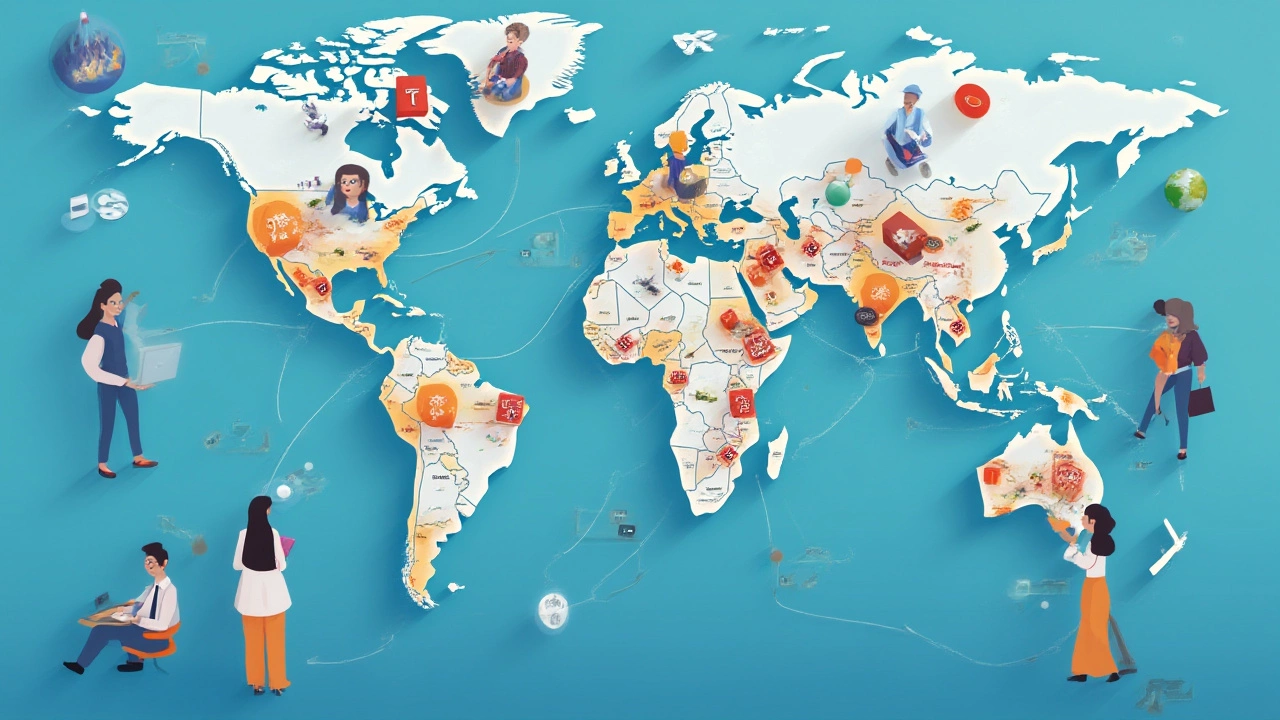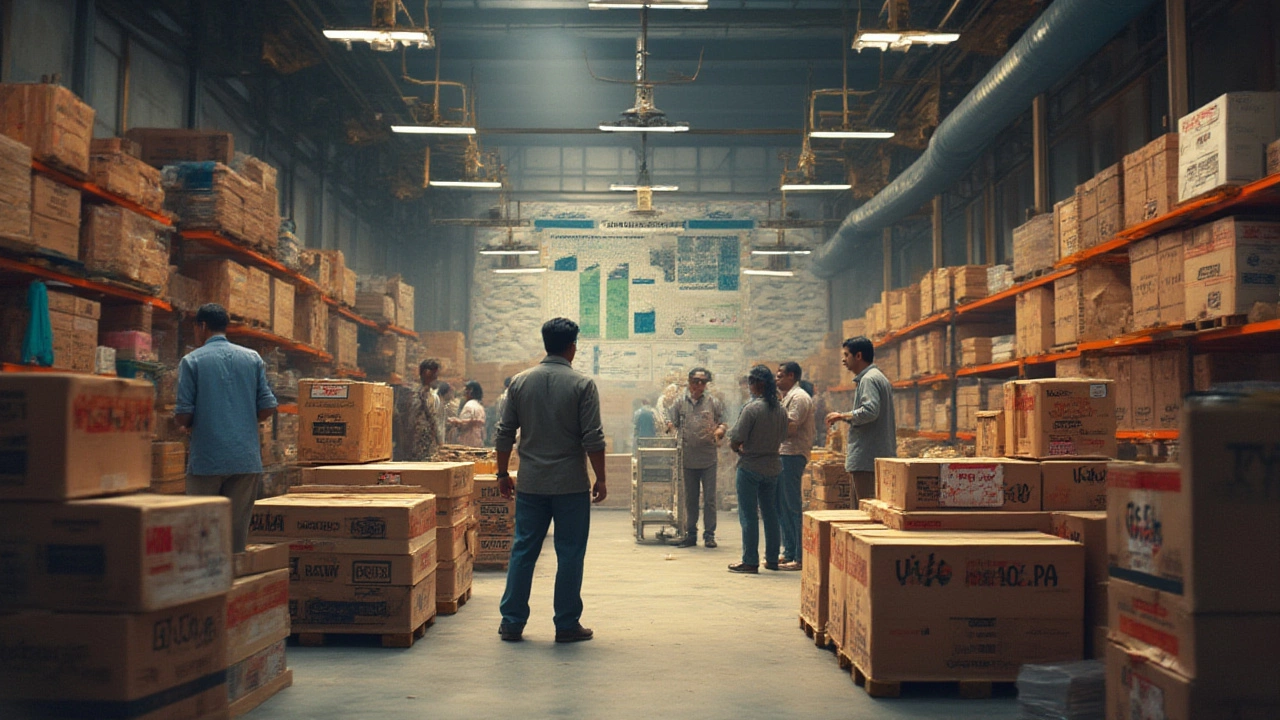If you ever spent time in a US grocery aisle, you’ve seen bags of Indian rice, jars of turmeric, and dozens of products stamped Made in India. But that’s just the tip of the iceberg. India isn’t just sending naan and Bollywood dreams to the States. It’s a logistics and innovation powerhouse, fueling some surprising corners of America’s economy. Want to know exactly what’s loaded on those vessels headed from Mumbai, Chennai, or Mundra ports, sent halfway across the globe?
India-US Trade: The Real Numbers and the Big Picture
Let’s start with some real retail-therapy-level numbers. As of last year, India sent over $120 billion AUD worth of goods to the United States, making America its largest export destination. If you break that down, the US takes about 18% of all products leaving India—a pretty serious trade partnership. During 2024, the US imported more from India than ever, thanks to shifting global supply chains, American companies looking to diversify away from China, and India’s government offering sweet incentives for exporters.
The official US trade data shows the top five categories from India aren’t just the usual suspects like textiles and spices. The real blockbusters are jewelry, machinery, chemicals, pharma, and—you guessed it—software services (but we’re focusing on physical products in this article). India actually sits among the top five supplier nations for gems and precious metals, pharmaceutical products, and vehicle parts shipped to the US.
The pandemic years put the spotlight on India’s ability to supply critical drugs and medical goods. The US now relies on Indian manufacturers for everything from common generic pills to critical heart medications. And it’s not slowing down: American demand for Indian-made goods just keeps skyrocketing, year after year. As the world’s most-populous democracy, India brings more than scale—it brings variety and resilience to global supply chains.
| Export Category | 2024 Value (USD Billion) | US % Share of Indian Export |
|---|---|---|
| Gems & Jewelry | ~13 | 27% |
| Pharmaceuticals | ~8.2 | 28% |
| Apparel/Textiles | ~7.6 | 21% |
| Engineering Goods | ~15.5 | 22% |
| Chemicals | ~8.4 | 25% |
| Seafood | ~1.7 | 30% |
| Rice & Food Products | ~0.9 | 17% |
What drives this growth? Rising incomes in the US, changing demographics (more Indian-Americans, more global palates), the "China +1" strategy, and American companies racing to partner with Indian manufacturers.
The Big Ticket Items: From Gold to Generics
Ask most people about Indian exports and they’ll say “spices, tea, or cotton.” That’s partly true, and these goods still headline the Indian export show. But let’s get specific. If you ever bought jewelry in the US—maybe a diamond ring or a gold bangle—you might be wearing a piece crafted in Mumbai’s glittering Zaveri Bazaar, shipped all the way to Manhattan, Vegas, or LA.
India exports over $13 billion USD in gems and jewelry to the US yearly, making it America’s #1 overseas bling supplier. This includes everything from cut and polished diamonds, colored stones, to finished gold and platinum pieces. Ever wonder where those “big box” US jewelers get their stunning diamond earrings? Odds are, it’s Surat or Jaipur doing the diamond cutting.
Moving past the sparkle—India’s pharmaceutical industry has become the world’s medicine chest. Indian factories ship out generic pills, bulk drugs, vaccines, and even advanced biologics. Almost 40% of every prescription generic sold in the US comes from an Indian plant. That’s antihistamines, antibiotics, blood pressure meds—you name it. The sheer breadth of India’s pharma exports was on show during COVID, when Indian firms supplied vital ingredients for vaccines and therapeutics to pharma giants like Pfizer and Moderna.
Apparel is a biggie too. Walk into any US department store and check the labels on the casual shirts, t-shirts, and dresses—you’ll spot “Made in India” all over, especially on natural fiber clothes. India supplies a massive chunk of US cotton garments, artisan handlooms, and even some high-fashion textiles. What’s changed lately? Indian fashion houses and exporters now mix high-tech fabrics with traditional craft, and American buyers love the fusion vibe.
But wait, there’s more. American warehouses stock up with Indian car parts, steel, rubber goods, tools, plastics, and high-tech machinery. Indian engineering goods (think: everything from transmission parts to pumps to transformers) punch well above their weight. That means the next time you drive a US-built car or use a washing machine, there’s a decent chance that some small but vital components inside are Indian-made.
Many might not expect it, but the US is now India’s top market for chemical exports, including dyes, pigments, and bulk specialty chemicals. These are essential not only for America’s manufacturing sector but also for paints, plastics, and electronics. Indian chemicals have quietly built a reputation for reliability—no wonder US buyers keep coming back.

Surprising Exports: Indian Shrimp, Spices, and IT Hardware
Let’s move away from bling and pills for a second. Did you know that the US gobbles up more Indian seafood—mostly shrimp—than any other country? If you’ve eaten grilled shrimp at a US restaurant chain or picked up frozen seafood at Walmart, you’ve probably tasted something raised in Andhra Pradesh or Odisha. The FDA imported over 250,000 tons of Indian shrimp last year alone, making India America’s main source for this delicacy. Even with strict US food safety checks, Indian seafood processors have held their ground, growing exports by investing in clean, tech-driven facilities.
Of course, it gets spicier—literally. If you like flavor, you’re indirectly part of this trade: India supplies around 60% of the world’s turmeric exports, with the US as a huge buyer. Indian cumin, cardamom, and chili are pantry staples in American homes, restaurants, and even in processed foods at massive chains. But it’s not just the original spices—India is now sending ready-to-eat meals, frozen curries, and international adaptions of Indian snacks to US shelves, grabbing a growing chunk of the “ethnic foods” market each quarter.
There’s another plot twist: Electronics. While China dominates here, Indian exports of mobile phones, cables, chargers, and computer hardware to the US have tripled in just five years. Apple assembler Foxconn, along with Indian brands, now produce millions of handsets in India, some ending up in US retail chains. The “Make in India” push, fueled by government incentives, is steering more big-name hardware brands into setting up Indian plants. Already, US companies are relying on India for key components in solar panels, power equipment, and even smart home gadgets.
One more small but fast-growing category is leather goods—wallets, bags, belts, and shoes—from crafty clusters in Kanpur, Chennai, and Kolkata. Americans love these for their blend of price, style, and durability. Exporters constantly tweak designs to match US trends, thanks to direct feedback from buyers and social media surveys. This nimbleness makes Indian brands increasingly visible at US boutiques and online shops.
Entrepreneur tip: Even smaller USA importers can source directly from Indian factories or via IndiaMART, the mega-B2B platform. This direct link trims away layers of middlemen, unlocking competitive prices and custom products.
How Indian Products Reach US Consumers—and Tips for Exporters
Imagine the journey from rural India to an American dinner table or shopping cart. Indian farmers, artisans, and factories might ship a product thousands of kilometers by truck or rail to one of India’s major ports. From there, it’s usually loaded into massive containers, heading to US gateways like New York, Houston, or Los Angeles. Once it clears customs, the goods split off to distribution centers, then on to supermarkets, jewelry stores, hospitals, pharmacies, boutiques, and online platforms like Amazon.
This journey isn’t without red tape. US import laws can be tough—food safety, product certifications, and anti-dumping regulations add cost and risk. Successful Indian exporters tackle these by hiring trade consultants in both countries, tech-upgrading their plants, and working with logistics specialists who know how to keep cold chains intact (think: frozen shrimp or vaccines).
If you’re a budding exporter, here’s what works:
- Build relationships with US buyers at trade shows in Vegas, New York, and Atlanta. Americans love face-to-face deals.
- Certify like a pro. US buyers demand FDA, FSSAI, ISO, and other approvals. No shortcuts here—the rules get stricter every year.
- Stay nimble on trends. US consumers shift fast, especially in food and fashion. Watch Reddit, Insta, and TikTok; what’s viral today is often tomorrow’s bestseller.
- Tap into logistics tech. Track every shipment from India to the US port and right to the warehouse. Delays eat margins fast.
- Try value addition. Instead of just raw materials, focus on selling finished, branded goods—like packaged snacks, ready-to-cook kits, or jewelry in custom boxes.
One cool tip: Today, Indian exporters of even modest size can sell directly on US eCommerce sites. Platforms like Amazon and Walmart Marketplace let Indian entrepreneurs skip traditional importers. You just register, list, and ship via Amazon’s logistics or a US-based warehouse. Yes, compliance is tricky; yes, payments can lag. But small firms report margins twice as high as through old-fashioned channels.
What’s the future? More Indian-made electric vehicles, drones, organic foods, handicrafts, and sustainable textiles—in step with American demand for eco-friendly and innovative products. And with the US pushing to "friendshore" critical supply chains, expect even higher trade numbers for years to come.
The next time you open an American pantry, unbox a smartphone, stroll into a pharmacy, or admire a shiny engagement ring, remember: odds are, there’s a slice of Indian sweat, skill, and entrepreneurial flair inside. Exports aren’t just about containers, customs, and contracts—they’re about forging the global connections that define the world’s biggest democracy and the world’s biggest economy.

